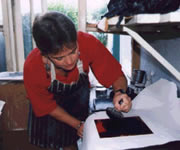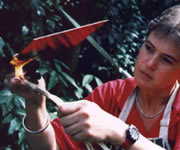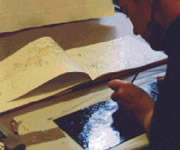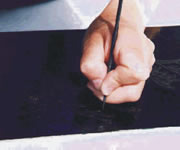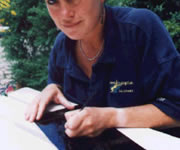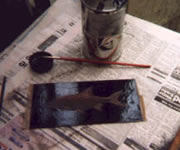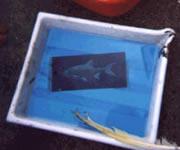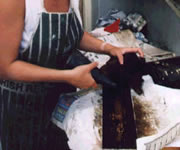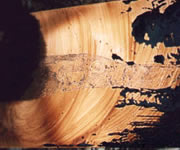- Amphibians
- Birds
- Cephalopods
- Cetaceans
- Coral Seas
- Crustaceans
- Fresh Water Fish
- Insects
- Jellyfish
- Mammals
- Molluscs
- My Designs
- Plankton
- Reptiles
- Salt Water Fish (UK)
- Sea Dragons
- Sea Horses
- The Twilight Zone

Newsletter
To keep track of my new work, exhibitions and what I am up to then simply enter your email here and my friendly penguin will update you with my latest news! Thank you
- Exhibitions
- 2011
- Society of Wildlife Artists Exhibition, Mall Galleries, London
- SAHFOS - Plankton 2011
- The Royal Academy Summer Exhibition
- 2009
- The Royal Academy Summer Exhibition
- 2009/8
- Commission from the Isle of Man Government for fish pictures for an educational poster
- 2008
- Illustrations for 'The Game Cook' cookbook by Norman Tebbit
- 2007
- The Royal Academy Summer Exhibition
- Dartmouth: Higher Street Gallery
- 'The Deep' in Hull
- 2007/6
- L'Oceanografic in Valencia
- 2002
- Aquarium Finisterrae in La Coruna, Spain
"I feel most strongly that we constantly take and profit from the sea and put very little of any good back in to it"
The sale of my work helps support the following projects & organisations:
The Etching Process
Wax Ground
The copper plate is heated and a thin layer of beeswax & tallow is melted and applied with a leather dabber to cover the surface of the plate. I move the plate on and off the heat until the finish is just right. It is important that the wax is exact and even across the surface of the plate.
Smoking the plate
The copper plate with the wax ground is held upside down in a hand vice and flaming tapers (thin long candles) are carefully waved underneath but not too close, the soot from the flames mixes with the thin layer of wax. The smoking of the plate hardens the wax creating a more resilient matt black surface on which to draw.
This creates what is known as a hard ground. A soft ground (using softer wax) is applied in the same way but the plate is not smoked. A soft ground allows for tracing, softer lines and textures.
Referring to my sketches
Having researched my subject, referring to my sketchbook and from life the image starts to develop. I often visit the Natural History Museum in London which is an incredible resource for my work.
Creating the image
The image is created by drawing with an etching needle onto the plate through the hard ground. The lines created expose the shiny copper underneath the layer of wax, and the black matt coating gives a strong visual contrast.
Finishing touches
Adding the final detail. Fish scales take a long time! Stop Out varnish is painted on the surface of the wax (or over any mistakes!) to prevent foul bite. To prevent the back of the plate etching I cover it with strips of brown parcel tape, cheaper than stop out varnish and you do not have to wait ages for it to dry!
Ready to etch the plate
The drawn and stopped out plate is now ready to go in to the acid bath. I use Nitric acid and I dilute it with water. The acid bites into the exposed lines on the plate, the feather is used to remove bubbles which form as the acid starts to bite.
Failure to 'feather' can lead to an uneven bite. The ambient temperature is a factor on the speed of the etching process. I often use a test strip of copper, which has a variety of marks and gradations which I time, stop out, etch, time, stop out etc. This gives me an accurate indication of the time required to complete the etching. During the etching the plate is removed and examined, I may stop out some areas to vary the bite.
Cleaning the plate
The etched plate is washed off in water and the stop out varnish and wax ground is removed using turps, this exposes the etched lines bitten into the copper. A tentative moment! As the image emerges you begin to picture how the finished print will look. Just prior to printing the edges of the plate are bevelled by filing and burnishing the edges. This gives a clean edge to the print and prevents marking or damaging the woollen blankets on the etching press. The burnisher I use was given to me by my art master Terry Currell who was given it as a student by Gertrude Hermes, it is very precious to me!








